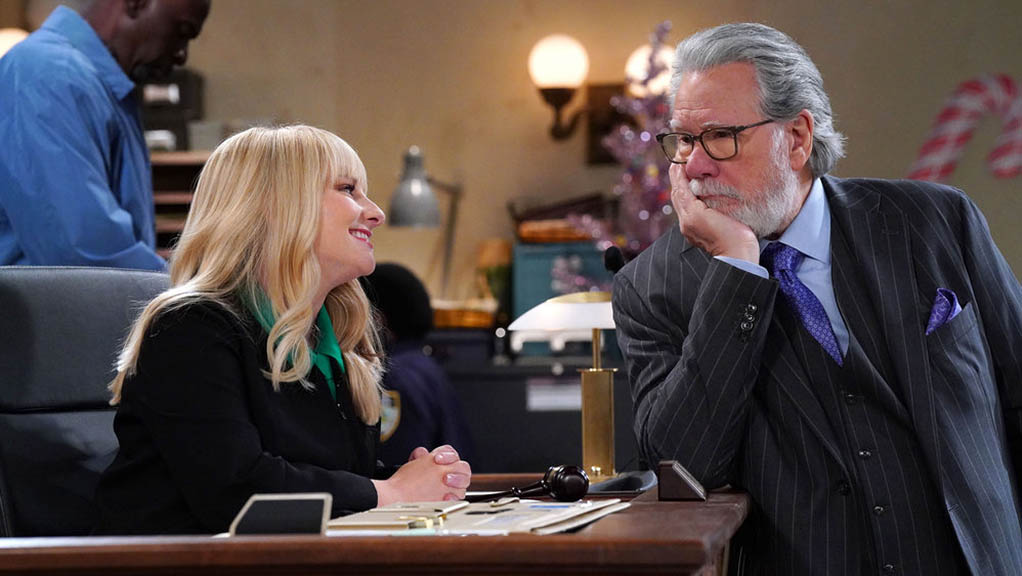Multicam Comedy ‘Renaissance’ Stays on Track
Laugh tracks may seem like a blast from TV’s past, but several new shows feature them

The laugh track, which fell out of favor when hipper single-camera comedies such as The Office and Brooklyn Nine-Nine drew substantial audiences and buzz, may be experiencing a rebirth. Among the series using them are Frasier, which recently received a second-season renewal on Paramount Plus, and a pair of NBC offerings, reboot Night Court, in season two, and rookie sitcom Extended Family. Viewers don’t care how many cameras are involved, producers on those shows said, as long as the show is funny, and actors said they feed off the studio audience.
Night Court star John Larroquette addressed the topic of comedies shot with multiple cameras (more like a stage play) versus a single camera (like a movie) during a Television Critics Association Winter Press Tour session on the Warner Bros. lot. “If you look at the landscape of four-camera, I don’t watch a whole lot of television, but it seems to me that it’s having a bit of a renaissance,” he said.
Single-Cam in Scranton
Some trace the single-cam trend to Malcolm In the Middle, which was on Fox from 2000 to 2007. Modern Family and 30 Rock were other popular single-cams with long runs that helped change the dynamic. “It taught [viewers] a new way to watch TV comedy,” Pittsburgh Tribune-Review TV critic Rob Owen said. “Viewers were taught to go without a laugh track, and it became easier to slam the laugh track as something one should be ashamed of.”
Current comedies with laugh tracks — audio with audience laughter — include The Conners on ABC, Bob Hearts Abishola and The Neighborhood on CBS and The Upshaws on Netflix.
For some, hearing canned laughter brings them back to watching TV in a different era, and not necessarily in a good way. A review of Night Court’s season two on The Daily Beast said, “The braying, instructive laugh track creates a halting rhythm of setups and punchlines closer to the person-to-person energy of the theater than the rapid-fire density of jokes flourishing over the past couple decades of standard-setting comedies.”
TCA president Jacqueline Cutler called laugh tracks “annoying.”
“I feel like it’s telling me how to feel when I know how to feel,” she said.
Broadcasting & Cable Newsletter
The smarter way to stay on top of broadcasting and cable industry. Sign up below
Extended Energy
Yet some multicam actors said it’s easier to be funny in front of an audience. At the TCA tour, Donald Faison, who plays Trey in Extended Family, shared that the studio audience gives actors “so much energy.”
He talked about shooting in front of the crew, and then of the joy of welcoming an audience into the studio. “You want to make every one of those people laugh just as much as you made the crew laugh,” Faison said.
Cutler said she’s heard from a number of comedy actors, particularly those with a stage background, about how they feed off the crowd. “They talk about needing that energy from the audience and how much they get from it,” she said.
Larroquette mentioned coming up with jokes while waiting for the audience to stop howling. “Some of the best comedy that’s ever come out of my world, out of my brain, was waiting for you to stop laughing,” he said. “Because if you’re shooting, you can’t just wait. You’ve got to stay alive.”
Multiple Multicams
Time will tell if multicam comedies retain their place in television. CBS has ordered a multicam spinoff of Young Sheldon, while ABC ordered a Tim Allen multicam called Shifting Gears.
Larroquette, for one, thinks the multicam will stick around. “The intimacy of four cameras and an audience sitting, watching it, and people at home know that it’s sort of like a little play that’s going on,” he said. “I have a feeling that that’s something that will always be desired.”
Owen noted that TV trends cycle in and out. “I do not think multicams will completely go away,” he said. “With television, there are always ebbs and flows for formats and styles.”
Speaking at the Warner Bros. lot during press tour, Chuck Lorre, whose shows have included multicams The Big Bang Theory, Bob Hearts Abishola and Two and a Half Men, called it “a wonderful form of storytelling.”
The audience, he said, does not care if a show is a single cam or multicam, as long as it is funny and they dig the characters. “Some of the greatest shows in the history of television have been in front of an audience,” Lorre said. “Why would that not be true now?”
Michael Malone is content director at B+C and Multichannel News. He joined B+C in 2005 and has covered network programming, including entertainment, news and sports on broadcast, cable and streaming; and local broadcast television, including writing the "Local News Close-Up" market profiles. He also hosted the podcasts "Busted Pilot" and "Series Business." His journalism has also appeared in The New York Times, The L.A. Times, The Boston Globe and New York magazine.

